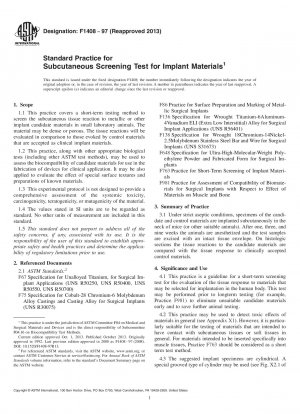ASTM F1408-97(2013)
Standard Practice for Subcutaneous Screening Test for Implant Materials
- Standard No.
- ASTM F1408-97(2013)
- Release Date
- 1997
- Published By
- American Society for Testing and Materials (ASTM)
- Status
- Replace By
- ASTM F1408-20
- Latest
- ASTM F1408-20a
- Scope
4.1 This practice is a guideline for a short-term screening test for the evaluation of the tissue response to materials that may be selected for implantation in the human body. This test may be performed prior to longterm testing (for example, Practice F981) to eliminate unsuitable candidate materials early and to save further animal testing.
4.2 This practice may be used to detect toxic effects of materials in general (see Appendix X1). However, it is particularly suitable for the testing of materials that are intended to have contact with subcutaneous tissues or soft tissues in general. For materials intended to be inserted specifically into muscle tissues, Practice F763 should be considered as a short term test method.
4.3 The suggested implant specimens are cylindrical. A special grooved type of cylinder may be used (see Fig.8201;X2.1 of Appendix X2) to allow tissue interlocking that could keep the implant in place and minimize tissue irritation through motion at the interface that otherwise could contribute to increased variance of the results. In case ungrooved cylinders are used (see Fig.8201;X1.2 of Appendix X2), probable motion at the implant/tissue interface must be taken into account. Control cylinders should be shaped like the test cylinders.
4.4 The type of surface preparation of the specimens can affect the tissue reaction, therefore the preparation procedure should be noted in the report. The test may be used to compare the effect of different surface structures or conditions of the same material or to assess the effect of various treatments of modifications of a material.
1.1 This practice covers a short-term testing method to screen the subcutaneous tissue reaction to metallic or other implant candidate materials in small laboratory animals. The material may be dense or porous. The tissue reactions will be evaluated in comparison to those evoked by control materials that are accepted as clinical implant materials.
1.2 This practice, along with other appropriate biological tests (including other ASTM test methods), may be used to assess the biocompatibility of candidate materials for use in the fabrication of devices for clinical application. It may be also applied to evaluate the effect of special surface textures and preparations of known materials.
1.3 This experimental protocol is not designed to provide a comprehensive assessment of the systemic toxicity, carcinogenicity, teratogenicity, or mutagenicity of the material.
1.4 The values stated in SI units are to be regarded as standard. No other units of measurement are included in this standard.
1.5 This standard does not purport to address all of the safety concerns, if any, associated with its use. It is the responsibility of the user of this standard to establish appropriate safety and health practices and determine the applicability of regulatory limitations prior to use.
ASTM F1408-97(2013) Referenced Document
- ASTM F136 Standard Specification for Wrought Titanium-6 Aluminum-4 Vanadium ELI (Extra Low Interstitial) Alloy (UNS R56401) for Surgical Implant Applications*, 1998-04-20 Update
- ASTM F138 Standard Specification for Wrought 18 Chromium-14 Nickel-2.5 Molybdenum Stainless Steel Bar and Wire for Surgical Implants (UNS S31673)
- ASTM F648 Standard Specification for Ultra-High-Molecular-Weight Polyethylene Powder and Fabricated Form for Surgical Implants*, 2021-04-01 Update
- ASTM F67 Standard Specification for Unalloyed Titanium for Surgical Implant Applications (UNS R50250, UNS R50400, UNS R50550, UNS R50700)*, 2017-03-01 Update
- ASTM F75 Standard Specification for Cobalt-28 Chromium-6 Molybdenum Alloy Castings and Casting Alloy for Surgical Implants (UNS R30075)*, 1998-04-20 Update
- ASTM F763 Standard Practice for Short-Term Screening of Implant Materials*, 2003-11-01 Update
- ASTM F86 Standard Practice for Surface Preparation and Marking of Metallic Surgical Implants*, 2021-06-01 Update
- ASTM F981 Standard Practice for Assessment of Compatibility of Biomaterials for Surgical Implants with Respect to Effect of Materials on Muscle and Bone*, 2003-11-01 Update
ASTM F1408-97(2013) history
- 2020 ASTM F1408-20a Standard Practice for Subcutaneous Screening Test for Implant Materials
- 2020 ASTM F1408-20 Standard Practice for Subcutaneous Screening Test for Implant Materials
- 1997 ASTM F1408-97(2013) Standard Practice for Subcutaneous Screening Test for Implant Materials
- 1997 ASTM F1408-97(2008) Standard Practice for Subcutaneous Screening Test for Implant Materials
- 1997 ASTM F1408-97(2002)e1 Standard Practice for Subcutaneous Screening Test for Implant Materials
- 1997 ASTM F1408-97 Standard Practice for Subcutaneous Screening Test for Implant Materials
